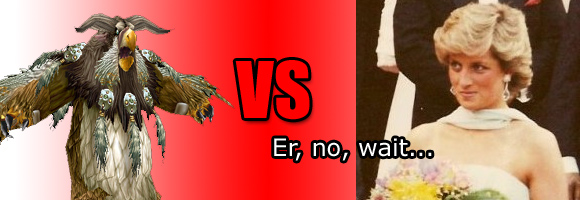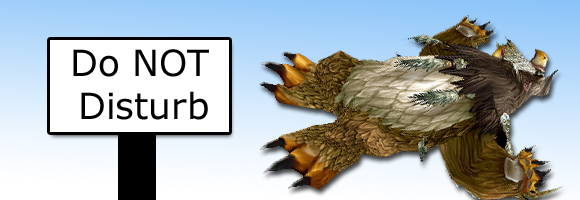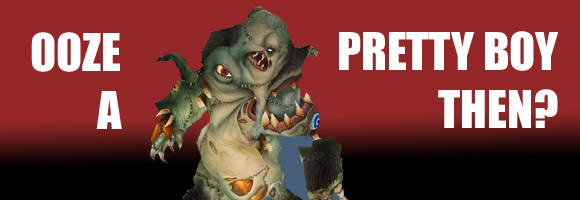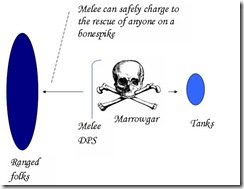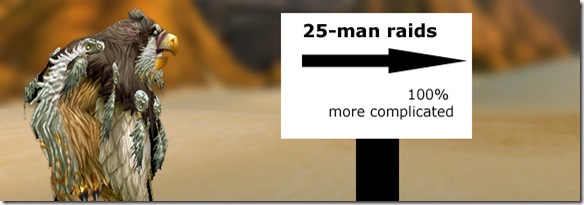So you’ve just met a charismatic, high-powered woman. You know the type. Legions of admirers. A woman capable of raising her followers up and empowering them on to great strengths. The sort of woman who reduces her enemies to insignificance with one touch. And then leaves them for dead on the floor. Oh, yes. You’ve just met Lady Deathwhisper. Want to take her down a peg or two? Here’s what you need to know.
This isn’t just hints and tips to help you get by. If you’ve met Deathwhisper and, more pointedly, the cobblestones in her lair, you’re the embittered adversary. You need a full guide on how to handle it. You need to know everything from basics to tricks for every role of your team. This guide is your friend. It’s going to walk you through the basic tactic for either 10 or 25 mans, and as a bonus I’ll throw in the alternative tactic for 25 mans and a note on the quest you may find yourself on to save Darnavan. It doesn’t matter if you’re there with a PUG group rather than a guild run. In fact, all the better if you are, because this guide assumes it’s not a given that your team know what to do. Just that they – and you – have a grudge against her Ladyship.
So an encounter with Deathwhisper follows a basic two-phase pattern. In the first phase the Lady will, like any leader-with-minions, stay at the back hiding behind a barrier while calling forth waves of minions to attack your group and doing some damage to random players with frostbolts and death and decay. You need to burn down her barrier – which is actually a mana shield – before phase 2 will kick in. Phase 2 is mostly a tank and spank affair, in which you just need to burn her down while she throws frostbolts, death and decay and angry ghosts at your party.
Tanks:
Left side will be 2 melee (fanatic) and 1 ranged (adherent) mobs. Any tanking class should be able to deal with this.
Right side will be 2 ranged (adherent) and 1 melee (fanatic) mobs. Ideally you want a DK or warrior on this side as they have more tricks for annoying ranged types.
- Be aware that the fanatics cleave: don’t move them around any more than you have to unless you want withering glances from your enhancement shaman.
- On 10 man the left and right side mobs appear alternately. On 25 man they appear at the same time, as well as an extra wave at the back, which consists of one random mob. You want to put your best kiting tank on the back wave: they tank that mob and take responsibility for kiting any deformed fanatics that spawn in the room.
- When Deathwhisper’s mana shield goes down your tanks need to tank the Lady herself. She stacks a debuff called Touch of Insignificance on the current tank. It reduces their threat generation by 20% and stacks to five; have your tanks taunt to swap on three stacks.
Healers:
This largely depends on what classes your healing team consists of, and that may or may not change the more times you bounce. The basics apply – if you have a holy paladin he should be able to take care of two tanks, using beacon. Otherwise, put your disc priest, or if they’re confident to do so, resto shaman on tanks.
Healers should just be ready for a lot of damage. More than the fight merits, probably. People will stand in death and decay, probably for a jot longer than they should. Melee might get cleaved in their own rush to get stabbing things. Got a reanimated adherent loose? Oh yep, he’s going to merrily throw deathchill bolts around until someone notices him. Not to mention frostbolt volleys and some rather unhappy ghosts thrown into the mix.
- Any healer who can cleanse curses – should. Everyone should drop what they’re doing and cleanse Curse of Torpor as soon as anyone in the raid is afflicted by it.
- Priests can help out by mass dispelling Adherents when they put up the spell reflect shield called Shield of the Occult.
- Watch your range – this room is just big enough to get out of range of your healing targets or them to outrange you. Be on your toes.
DPS:
Basic kill order:
Deformed Fanatic > Empowered Adherent > normal Fanatic/Adherent > Reanimated Fanatic Adherent > Deathwhisper
- Some people place reanimated as a higher priority than normals – I don’t, because the less normal adds you have running around the less reanimated adds you might get.
- Deformed/reanimated fanatics are mostly immune to physical damage: ranged DPS need to kill them. Empowered/reanimated Adherents are mostly immune to magical damage, so they’re meleers’ priority.
- Normal adherents can be interrupted when casting Deathchill Bolt. They can also be deathgripped. Just be careful not to interrupt or deathgrip them while they have Shroud of the Occult up because it’ll bounce and you’ll be interrupted or, as our unlucky DK found, deathgripped to them. Adherents’ Curse of Torpor should be removed from the party by anyone who can (mages, boomkins, we’re looking at you).
- Melee should watch out for Reanimated Adherents – we find it can be easy to miss them by assuming that adherents that drop dead are dead, rather than the actual case of the Lady about to reanimate them
- Normal fanatics cleave. Melee: be sure to stand behind them, eh? Fanatics also have an ability called Vampiric Might, which can be spell stolen by mages.
- Deathwhisper also mind controls party members on 25 man, one on normal, more on Heroic. DPSers should be ready to CC and snare/slow them before they cause havoc.
- We also generally find it useful to have some pre-arranged DPS focus solely on the boss in order to get her mana shield down and phase 2 started. In 10 man we have one DPS do this (our enhancement shammy due to her mixture of magical and physical damage making neither add type overly suited to her). In 25 man, at least three should stay on the boss.
- We’ve found that if you’re a DPS class with a pet it’s generally worth leaving the pet to DPS Deathwhisper unless your pet has an ability that makes him move quicksmart. Otherwise the travel time dragging him around the room will significantly reduce his overall DPS. And give him aching legs.
- As a last tip and trick, our DK has also found that anti-magic shield is your friend in phase 2. It helps the healers and takes a bit of pressure off all round – and you get free runic power. Win.
The above are exact tactics for 10 man version and extra explanations for 25 mans where necessary. There is an alternative 25 man tactic:
The entire group stands behind Deathwhisper. You can get into position before the fight starts. Melee adds will come towards healers and should be taken down on the way to them in a snare-and-AoE heavy zone created by the ranged DPS. The tanks draw ranged adds in by line of sighting them using the pillars. This tactic has the benefit of reducing run distances for melee and switching times for everyone: the entire group will get more time nuking through Deathwhisper’s mana shield. It’s not so great when everyone’s bunched together and a death and decay patch hits, though.
Oh, and if you find yourself charged with rescuing Darnavan from Deathwhisper’s charms in return for a Sack of Frosty Treasures, the following are all viable tactics when he spawns (usually in the first wave of adds):
- Have a plate meleer (preferably with some tank kit) tank him off to the side. Be careful not to do too much damage to him as he doesn’t have that much health.
- Have a hunter pet do the same. It may be difficult for the pet to get it away from the tank. Our hunter solved this with a distracting shot and a bit of kiting to a safe spot where his pet could taunt and tank
- Have a druid root him, continually. Other CCs don’t work
So, that should be all. Follow these tactics and you should suitably reduce Deathwhisper – that is, to nothing more than a pile of gaudy wrappings under your boots. Ah, justice. Oh, and the elevator will likely land on your head. Don’t be alarmed, elevators aren’t nearly as painful as Deathwhisper laying you low.
How about you? Do you think I’ve forgotten anything glaringly obvious, or have any small tips and tricks to share? This fight is still one of those that can turn from peachy fine to disaster in seconds – do you regularly have problems with this fight? Do you think there are any particular group setups which work better for this fight – or make it all the more challenging?
